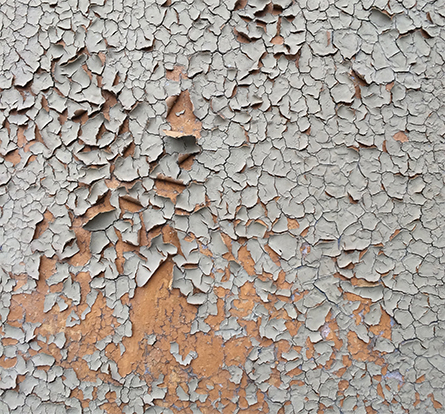From the journals: JLR
How psoriasis changes skin lipids. It doesn’t take guts to secrete PCSK9. Anchoring NOD2 on the plasma membrane. Read about papers on these topics recently published in the Journal of Lipid Research.
How psoriasis changes skin lipids

of dead skin cells.
Psoriasis is an inflammatory disease affecting the outer layer of the skin, or epidermis, which serves as a critical barrier against infection, chemicals and loss of nutrients and water. Psoriasis compromises skin barrier function and causes epidermal skin cells to proliferate, forming raised plaques and scales on the skin.
While skin lipids — fatty acids, ceramides and cholesterol — are essential for maintaining a healthy epidermis, researchers do not yet know the exact composition of skin lipids in healthy and disease states. As the epidermal skin barrier is formed, ceramides must be oxidized by lipoxygenase enzymes, or LOXs. Mutations of these LOX enzymes disrupt the skin barrier so that the skin loses water and becomes dry, red and scaly. Despite this, researchers have not fully characterized the products of LOX oxidation of ceramides and their roles in maintaining the skin barrier.
Victoria J. Tyrrell and colleagues at Cardiff University used new mass spectrometry–based methods to characterize the LOX pathway ceramides present in the human epidermis and determine how these lipids change in psoriasis. Their results, published in the Journal of Lipid Research, demonstrate that substrates of the LOX ceramide pathway are elevated in psoriatic patient skin, even in the absence of plaque, whereas oxidized ceramide products are reduced. They also found that psoriatic lesions had more oxidized free fatty acids than nonlesion or healthy skin, but the implications of this are unknown. In psoriasis, many genes were upregulated in the LOX ceramide oxidation pathway, which is required to form the epidermal barrier, possibly as an attempt to repair barrier function. Using network analyses, they identified a potential master regulator of these genes as the zinc finger transcription factor ZIC1.
While ZIC1 stimulates proliferation of some tumor cells, it had not been associated previously with skin cell proliferation during psoriasis. The authors state that ZIC1 is a potential new drug target for psoriasis.
It doesn’t take guts to secrete PCSK9
Too much low-density lipoprotein, or LDL, cholesterol clogs the arteries so they can no longer pump enough blood. This can cause a heart attack or stroke. LDL cholesterol is cleared out of the bloodstream by the liver LDL receptor — unless the receptor has been degraded.
The latest cholesterol-lowering drugs prevent LDL receptor degradation. These drugs target proprotein convertase subtilisin/kexin 9, or PCSK9, a protein that escorts the LDL receptor along the path to degradation. PCSK9 is highly expressed by the liver and intestines, but only the liver is known to secrete PCSK9 into the bloodstream — where it controls liver LDL receptor expression. Researchers are debating whether the intestines secrete PCSK9.
In a study in the Journal of Lipid Research, François Moreau, Aurélie Thédrez and colleagues at the University of Nantes report that human intestinal explants and mature human intestinal Caco2 cells do not secrete PCSK9. In mice lacking liver PCSK9, they detected no PCSK9 in the portal vein — a conduit between the intestines and liver — ruling out the possibility that it transports intestinally secreted PCSK9 to the liver LDL receptors. This study emphasizes the role of PCSK9 secreted by the liver in regulating cholesterol homeostasis.
Anchoring NOD2 on the plasma membrane
Crohn’s disease causes chronic inflammation of the digestive tract. Possible triggers include changes in the gut microbiome and genetic factors. One of the strongest risk factors for Crohn’s disease is mutation of an immune system protein called nucleotide-binding and oligomerization domain protein 2, or NOD2.
Within a cell, NOD2 senses peptidoglycans — the basic unit of the bacterial cell wall — that bacteria shed during infection. Then, NOD2 activates the host immune response, which requires its attachment to the cell membrane. Two cysteine residues on NOD2 can be linked to the fatty acid palmitate, thus anchoring it to the membrane.
In a new Images in Lipid Research publication in the Journal of Lipid Research providing further evidence for a study published in the journal Science in 2019, Charneal Dixon and Gregory Fairn at the University of Toronto show how they performed metabolic labeling experiments in HCT116 human colon cancer cells and showed that wild-type NOD2, but not a double cysteine mutant, was labeled with a palmitate mimetic. Additionally, the double cysteine mutant failed to reach the cell membrane. Knowing these cysteine residues are linked to palmitate, the researchers inferred that the surface of NOD2 interacts with the cell membrane. Defects in NOD2 membrane recruitment, which is critical for its ability to sense and respond to bacterial pathogens, are associated with inflammatory disorders, including Crohn’s disease.
Enjoy reading ASBMB Today?
Become a member to receive the print edition monthly and the digital edition weekly.
Learn moreGet the latest from ASBMB Today
Enter your email address, and we’ll send you a weekly email with recent articles, interviews and more.
Latest in Science
Science highlights or most popular articles

Small protein plays a big role in viral battles
Nef, an HIV accessory protein, manipulates protein expression in extracellular vesicles, leading to improved understanding of HIV-1 pathogenesis.

Genetics studies have a diversity problem that researchers struggle to fix
Researchers in South Carolina are trying to build a DNA database to better understand how genetics affects health risks. But they’re struggling to recruit enough Black participants.

Scientists identify new function of learning and memory gene common to all mammalian brain cells
Findings in mice may steer search for therapies to treat brain developmental disorders in children with SYNGAP1 gene mutations.

From the journals: JBC
Biased agonism of an immune receptor. A profile of missense mutations. Cartilage affects tissue aging. Read about these recent papers.

Cows offer clues to treat human infertility
Decoding the bovine reproductive cycle may help increase the success of human IVF treatments.

Immune cells can adapt to invading pathogens
A team of bioengineers studies how T cells decide whether to fight now or prepare for the next battle.

